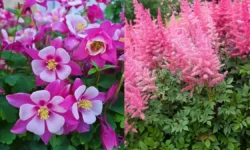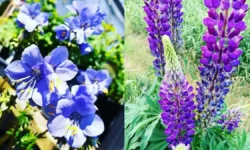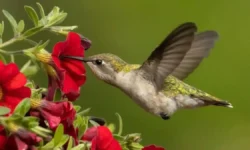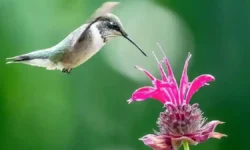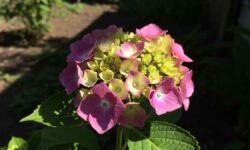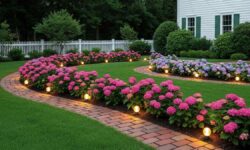Here’s my real-world guide to [hanging flowers to attract hummingbirds]—the easy, pretty way I turn a plain porch into a tiny bird café. I’ll walk you through exactly which blooms work, where to hang them, and how to keep nectar flowing all season. I’m picky about combos and baskets, but the honest truth is this: when you pack your space with hanging flowers to attract hummingbirds, you’ll see color, movement, and those speedy wings zipping by your morning coffee.
Table of Contents
Best hanging flowers to attract hummingbirds: quick-start guide
Before we get into the long list, here’s the short recipe I swear by: pick 3–5 hanging flowers to attract hummingbirds with different bloom shapes (tubes, bells, clusters), place baskets at varied heights, and keep water + fertilizer steady but light. Fuchsia + calibrachoa + lobelia is a go-to trio for a shady porch; petunia + lantana + verbena for hot sun. Multiple trusted roundups consistently recommend these exact plants (like fuchsia, petunias, calibrachoa, lantana, verbena, lobelia, impatiens) for baskets that hummers can’t resist.
Fuchsia (classic shade diva) — one of the best hanging flowers to attract hummingbirds
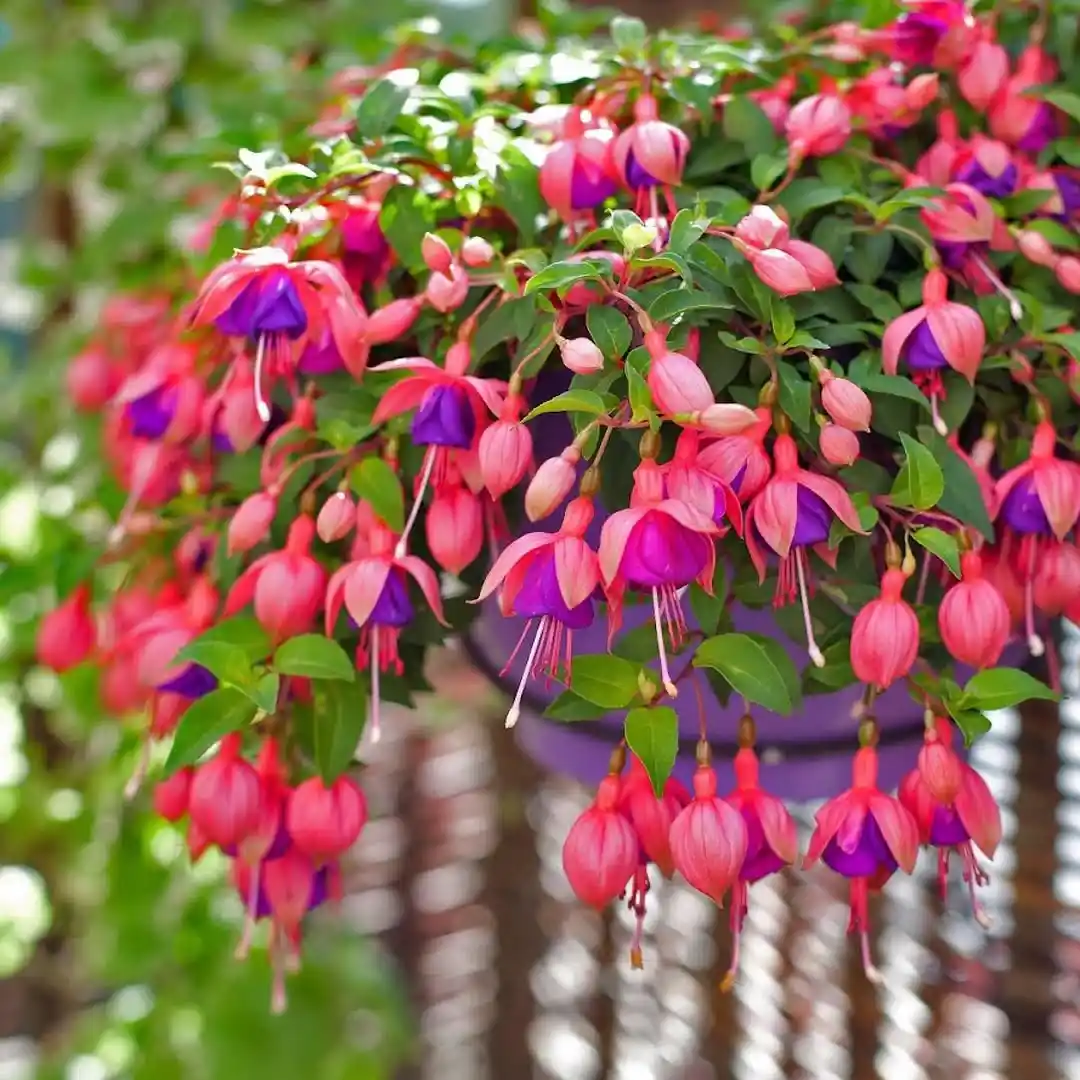
The pendant, lantern-like blooms on fuchsia are basically hummingbird invitations. I love how the bicolor skirts—magenta and royal purple or cherry and white—dangle where birds can hover and sip without fuss. If you’ve ever wanted a bit of fairy-garden drama, this is it. Flowers are tubular enough for easy nectar access and the show is nonstop when temps stay mild.
Grow it in bright shade or morning sun/afternoon shade; fuchsia prefers even moisture (never bone-dry), rich potting mix with great drainage, and steady, diluted feed in containers. Most hybrid fuchsias are tender perennials in USDA Zones 9–11 and treated as annuals elsewhere; hardy species like Fuchsia magellanica can overwinter colder. Hang near eye level so you can actually see the visits.
Petunia — bold color waterfall and reliable hanging flowers to attract hummingbirds
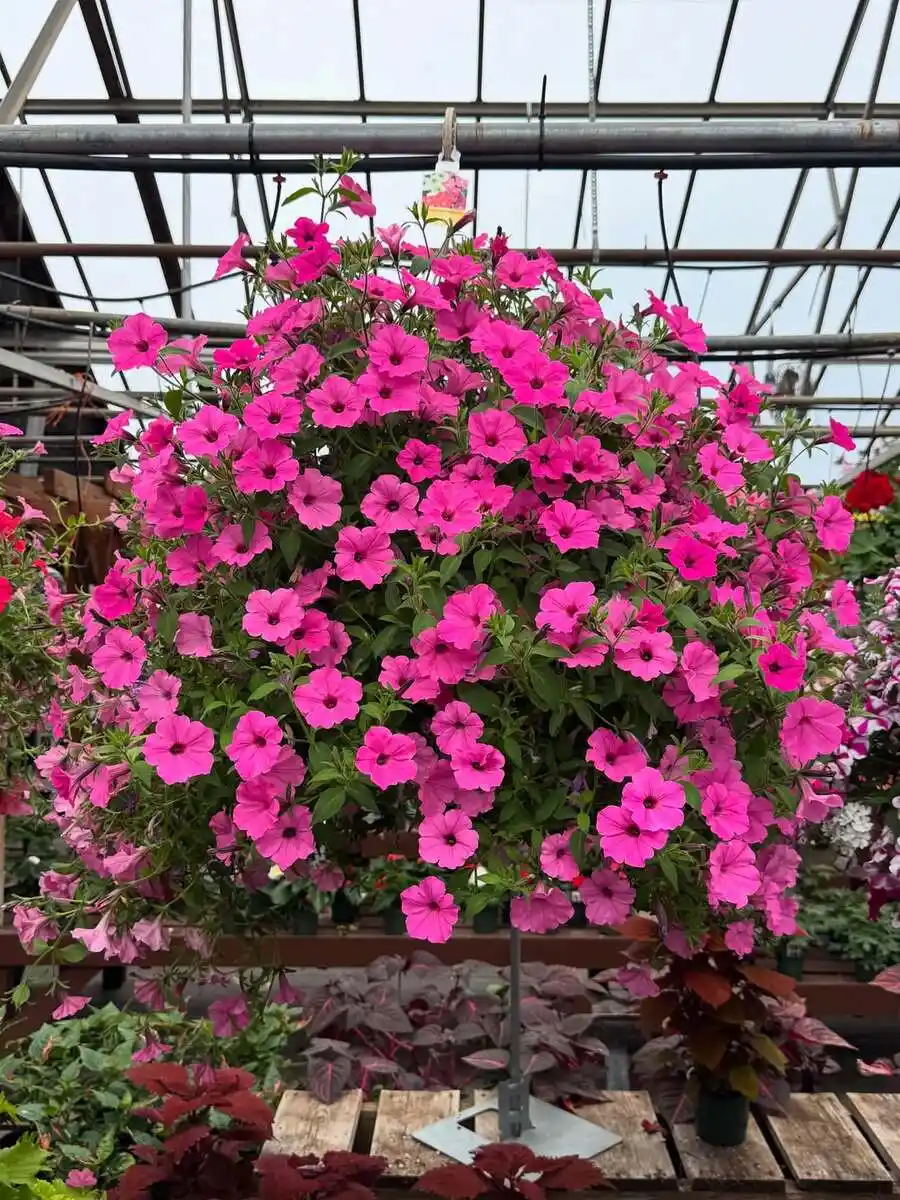
Petunias are the crowd-pleaser. Trumpet blooms in every color (reds, pinks, purples, even near-black) turn a basket into a color bomb. The fragrance on some varieties is sweet at dusk, and that trumpet shape? So easy for hummingbirds.
Give petunias full sun (6+ hours) and a roomy basket, keep soil evenly moist but not soggy, and pinch or deadhead for insane flower count. They’re typically annuals, perennial only in warm Zones 10–11. I mix in slow-release fertilizer at planting and then feed lightly every 1–2 weeks because baskets get flushed by frequent watering.
Calibrachoa (Million Bells) — compact, constant bloomers for hummingbird baskets
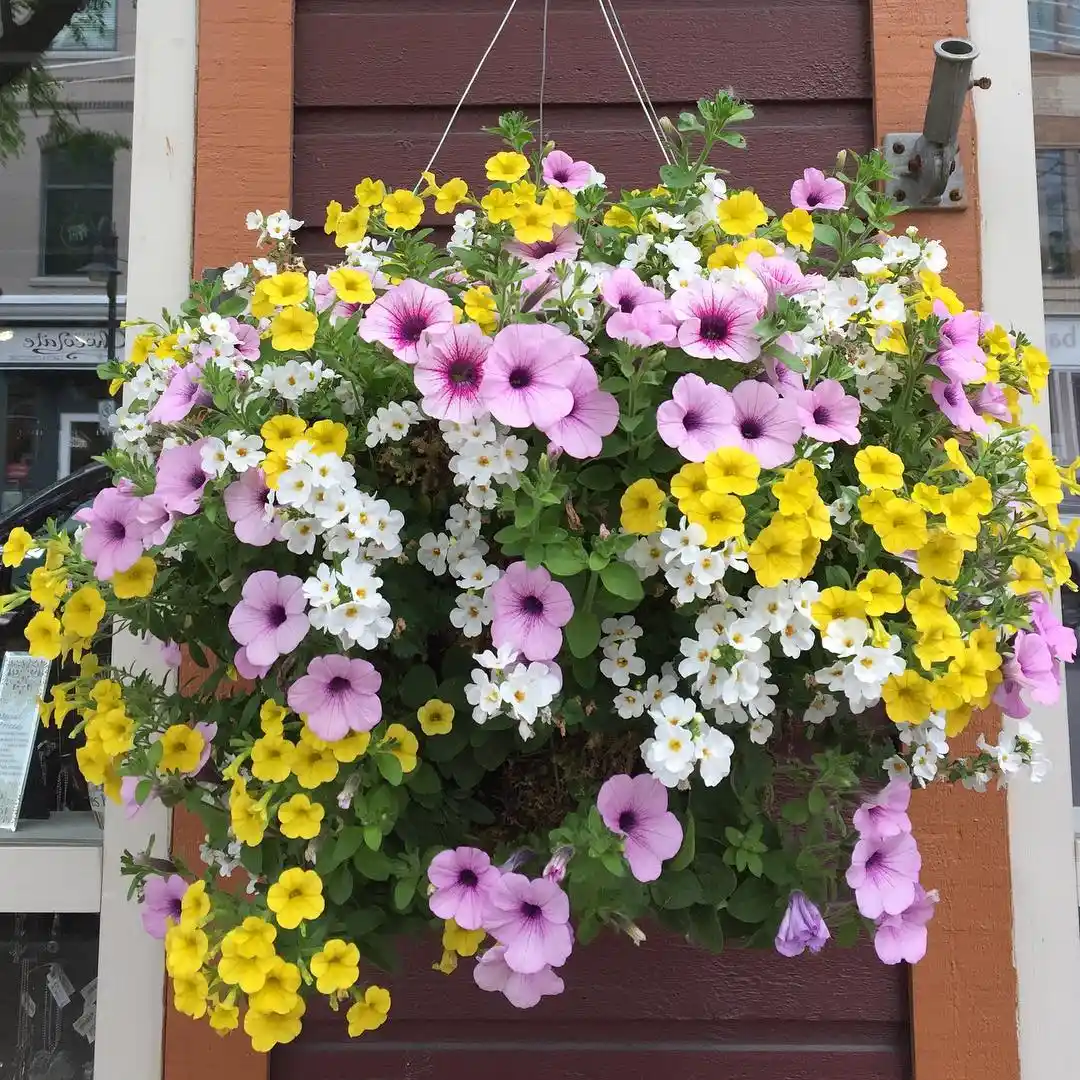
Think of calibrachoa as tiny petunias that refuse to quit. The mini trumpets cascade so nicely that one pot looks like a floral fountain. I use them when I want texture without bulky foliage. Hummingbirds work each little bell like a vending machine row.
Plant in full sun to part sun, very well-drained soil (they sulk in soggy media), and feed lightly throughout the season. They’re perennial in Zones 9–11 but grown as annuals elsewhere. For baskets, choose 12–14″ diameter so the plant can mound and spill. These are top performers for continuous bloom and nectar.
Lantana (trailing or mounding) — heat-loving hanging flowers to attract hummingbirds
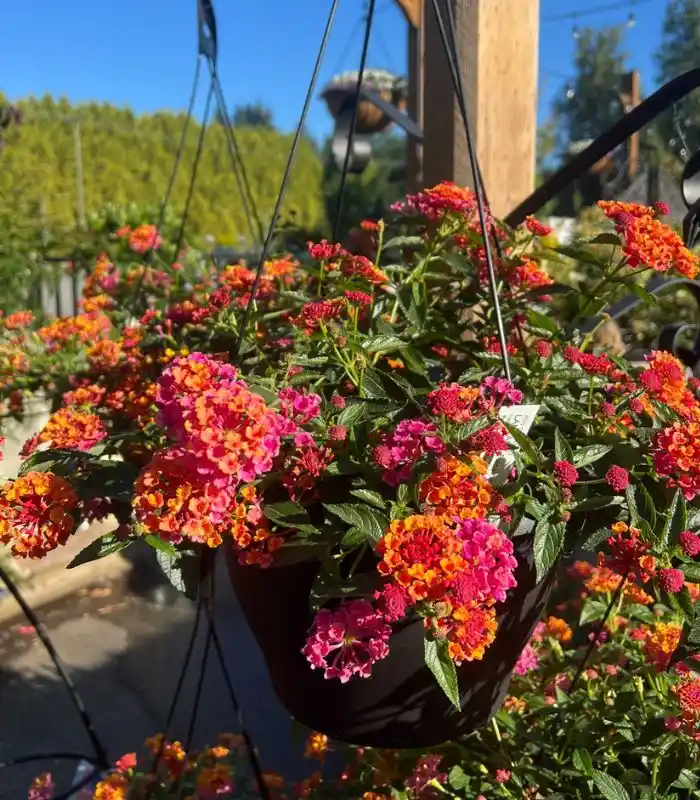
When your summer is hot and bright, lantana steps in like a sun-worshipping champion. Those clustered umbels change color as they age (peach to orange to red, or yellow to pink), which makes a single plant look like a full bouquet. Hummingbirds notice the warm palette instantly.
Grow in full sun, lean well-drained soil, and let it dry slightly between waterings. Trailing forms like Lantana montevidensis work beautifully in elevated baskets. In Zones 8–11 lantana can act as a perennial; elsewhere it’s annual. Give it a haircut midseason for a fresh wave of flowers.
Verbena (trailing) — nectar clusters that keep birds looping
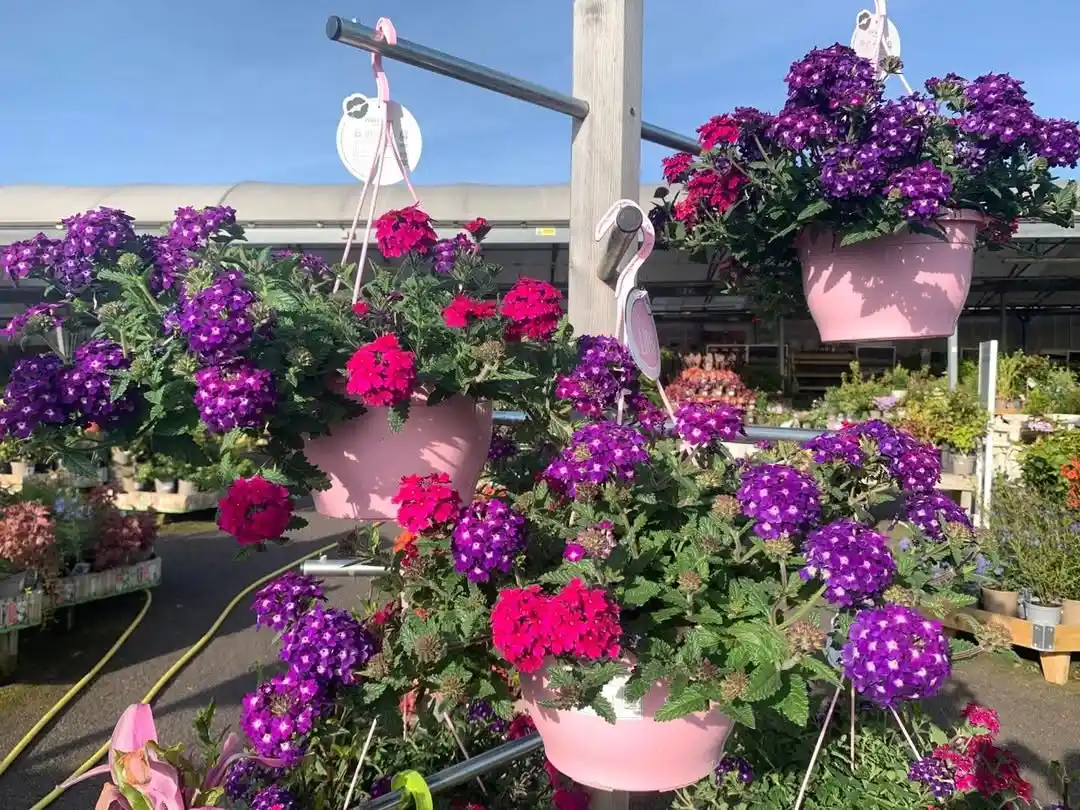
Verbena makes those soft mounds that spill over basket rims with clusters of nectar-rich florets from spring to frost. I use it as the “connective tissue” between larger blooms; hummingbirds ping from cluster to cluster like they’re playing a rhythm game.
Full sun, excellent drainage, and light weekly feeding keep it blooming. Most hybrids behave as annuals; in warm Zones 7–11 some can overwinter. Deadhead for more flowers or shear lightly if bloom slows.
Lobelia (Lobelia erinus) — cool-tone cascade that pops in shade gardens
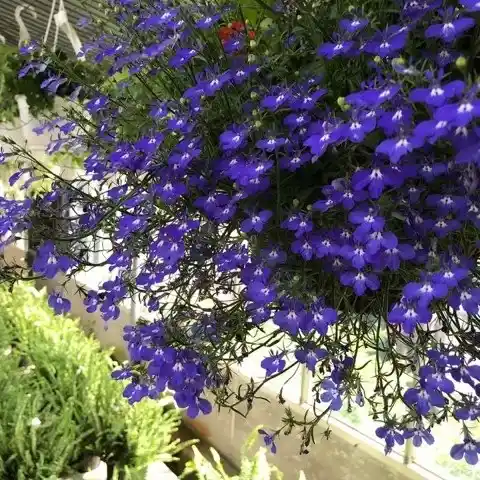
That cobalt or sapphire curtain is the reason I always tuck a lobelia near the basket edge. The small tubes and dense bloom count create a steady nectar buffet. In cooler climates, lobelia shines all summer; in heat, it appreciates afternoon shade.
Give it part sun to bright shade, consistently moist soil, and extra airflow. It’s tender (Zones 10–11) and usually grown as an annual. When the first flush fades, cut it back and feed—fresh color returns quickly.
Impatiens (including New Guinea) — shade-friendly hanging flowers to attract hummingbirds
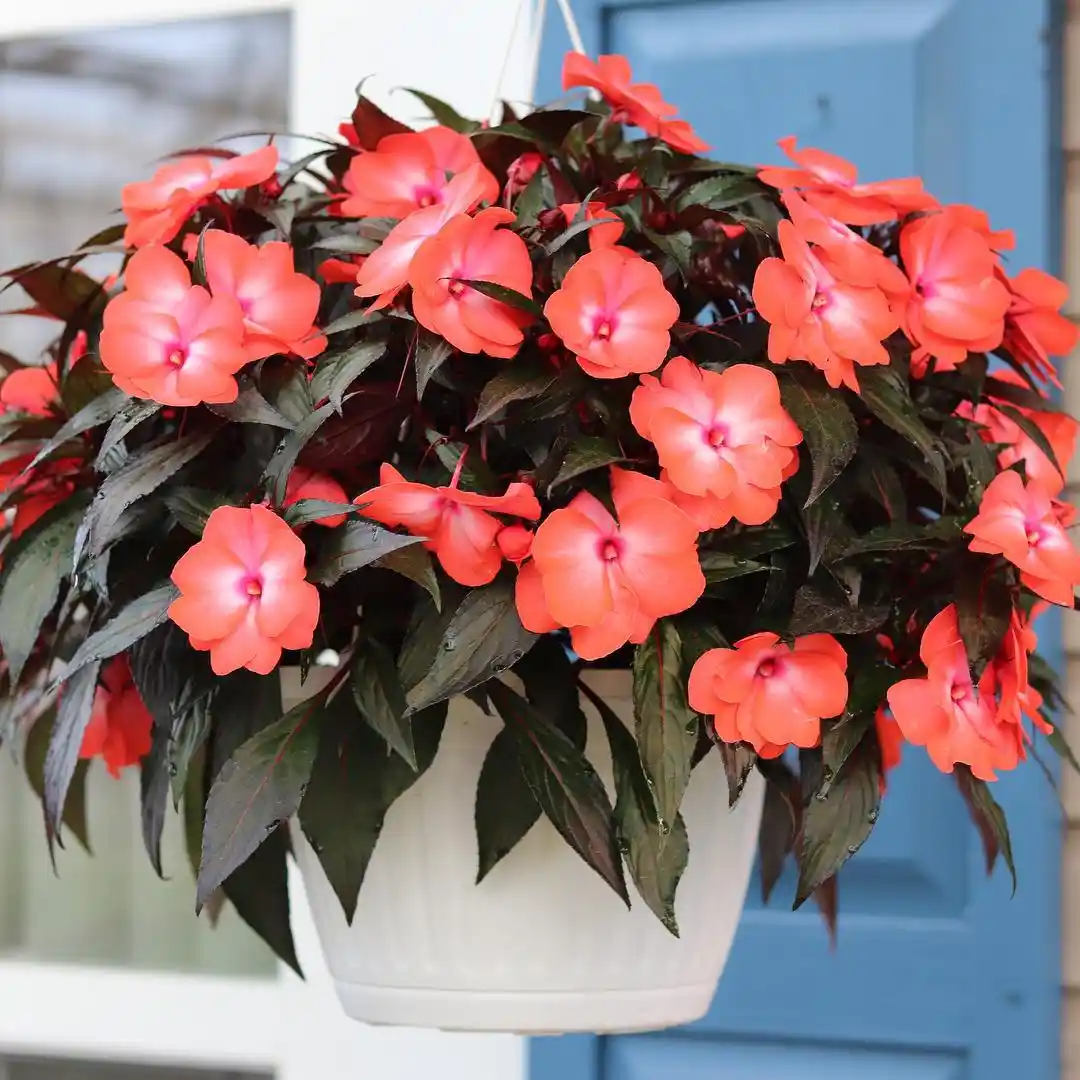
I have a soft spot for impatiens on porches where sun is scarce. The single, simple blooms in coral, hot pink, salmon, or white make a soft carpet, and hummingbirds zip in for fast sips, especially during migration bursts. New Guinea types bring glossy leaves and bigger flowers.
Provide bright shade, even moisture, and rich, fluffy potting soil. In Zones 10–11 they’re perennial; elsewhere annual. Space plants so air can move, and feed lightly every week or two for continuous color.
Begonia (especially Begonia boliviensis) — tubular bells for dappled light
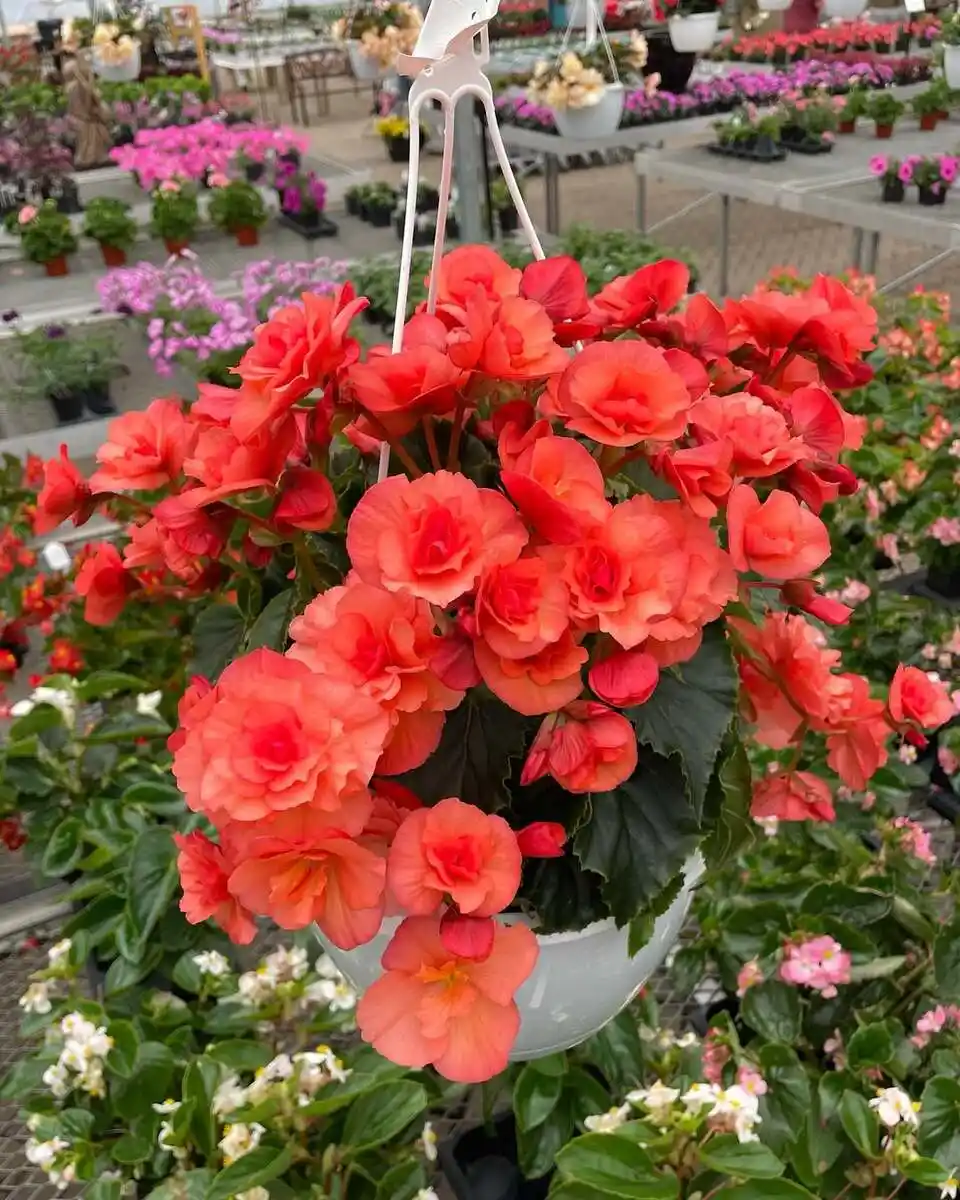
Tuberous boliviensis begonias throw out drapey, tubular blooms that hum with activity in the morning. Red and orange cultivars are my most visited. If your porch gets bright shade or cool morning sun, you’ll get orchestra-level performance.
Plant in part shade, with moisture-retentive but draining soil, and never let the tubers sit in cold, wet media. In Zones 9–11, they can be kept over; elsewhere, lift and store tubers dry. Pinch lightly to shape.
Cuphea (cigar plant & bat-faced cuphea) — tiny tubes, nonstop show
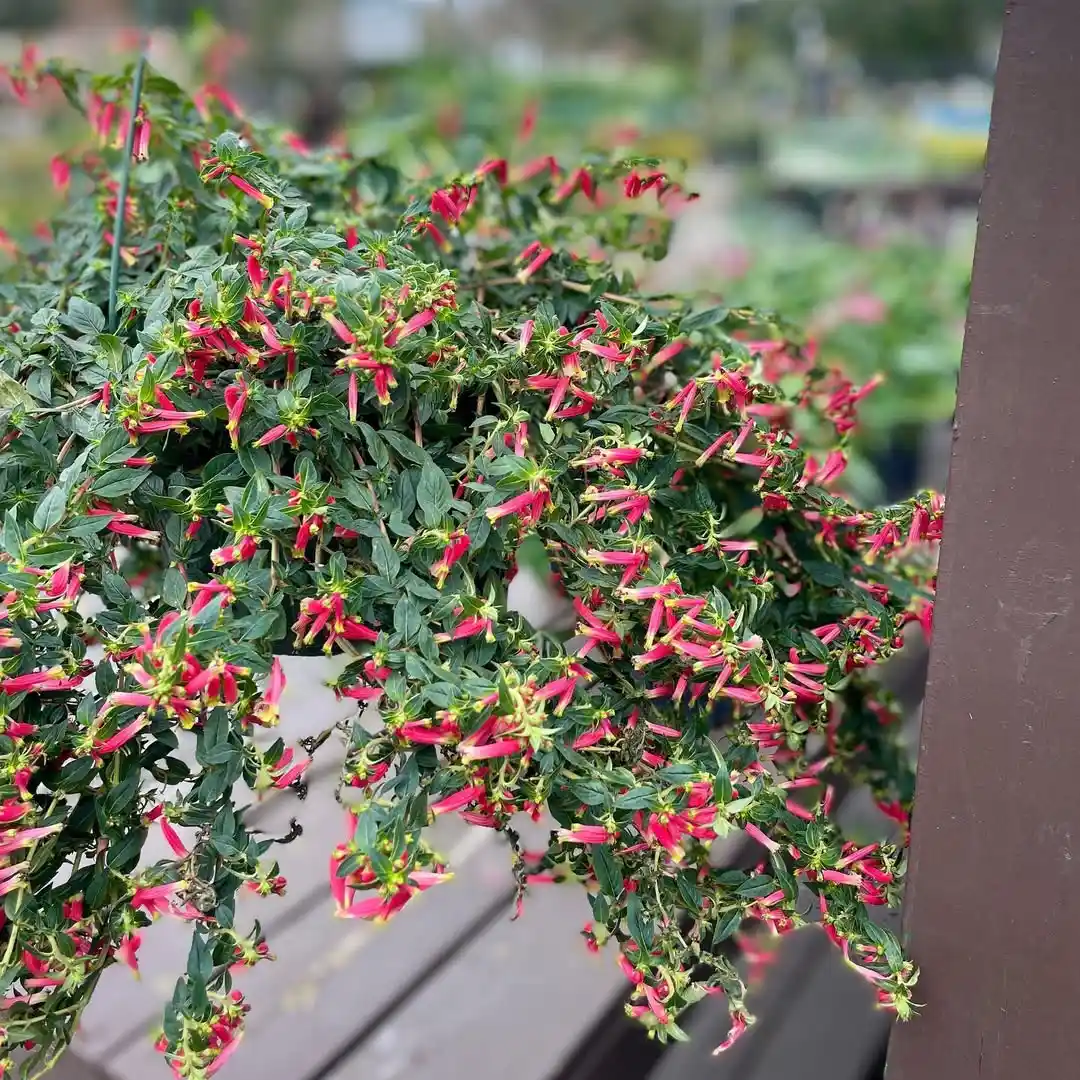
Cuphea is funny and fantastic. The flowers look like cigarettes (or little bat faces), and hummingbirds treat them like snack sticks. I run cuphea in the sunniest balcony spots because it handles heat better than I do in July.
Full sun, sharp drainage, and steady moisture (but never swampy) give you months of bloom. It’s perennial in Zones 9–11, otherwise annual. Shear once midseason to re-bulk.
Bidens (Bidens ferulifolia) — golden drape for hot porches
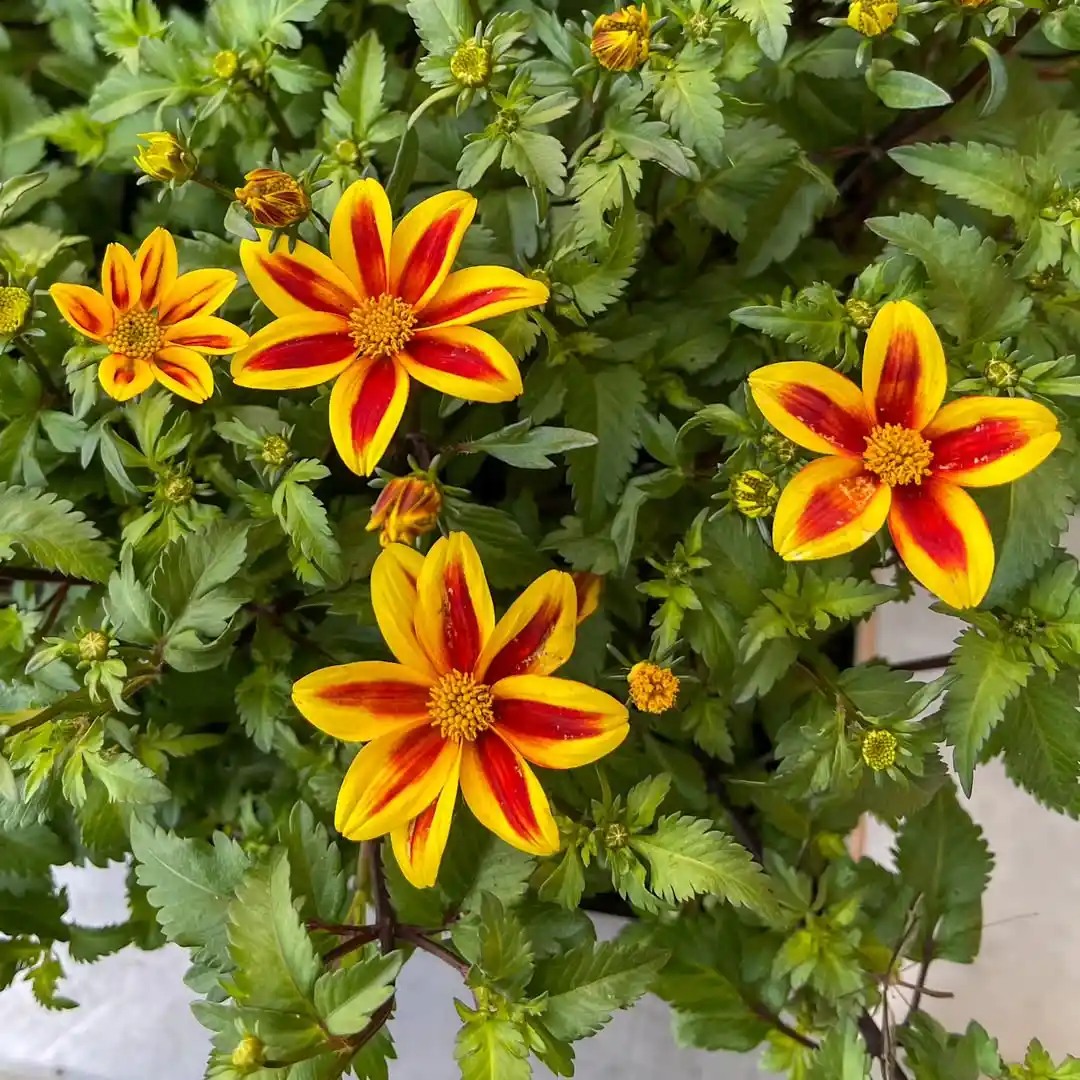
When I want pure sunshine color, I grab bidens. The daisy-like blooms are small but so abundant they read as a solid golden waterfall. Are they tubular? Not really, but the sheer number of nectar points draws regular fly-bys, especially when paired with red tubes nearby.
Give bidens full sun, excellent drainage, and lean feeding (too much nitrogen = more leaves than flowers). Typically annual, sometimes perennial to Zones 8–11.
Nasturtium (Tropaeolum majus) — edible blooms that hummers and salad both adore
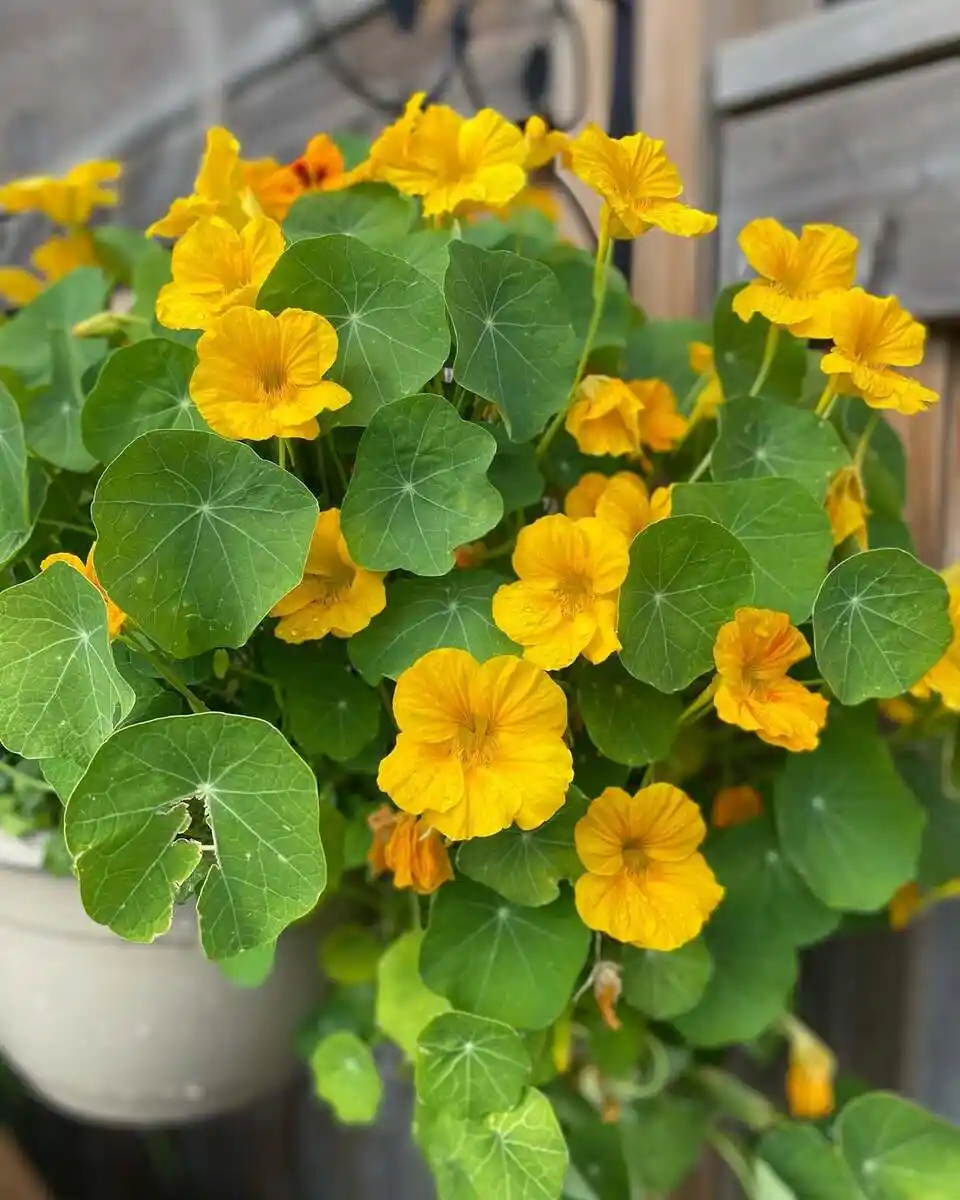
This plant might be my budget secret. You drop the seeds in, and a few weeks later those saucer-shaped leaves and spicy, funnel-shaped blooms are spilling down like confetti. Red-orange shades feel extra “hummer-y.”
Full sun for best bloom (light shade tolerated), average to poor soil (rich soil = leaves not flowers), and modest water once established. It’s annual almost everywhere, reseeding pleasantly. Bonus: petals taste peppery in salads.
Ivy Geranium (Pelargonium peltatum) — classic trails, dependable traffic
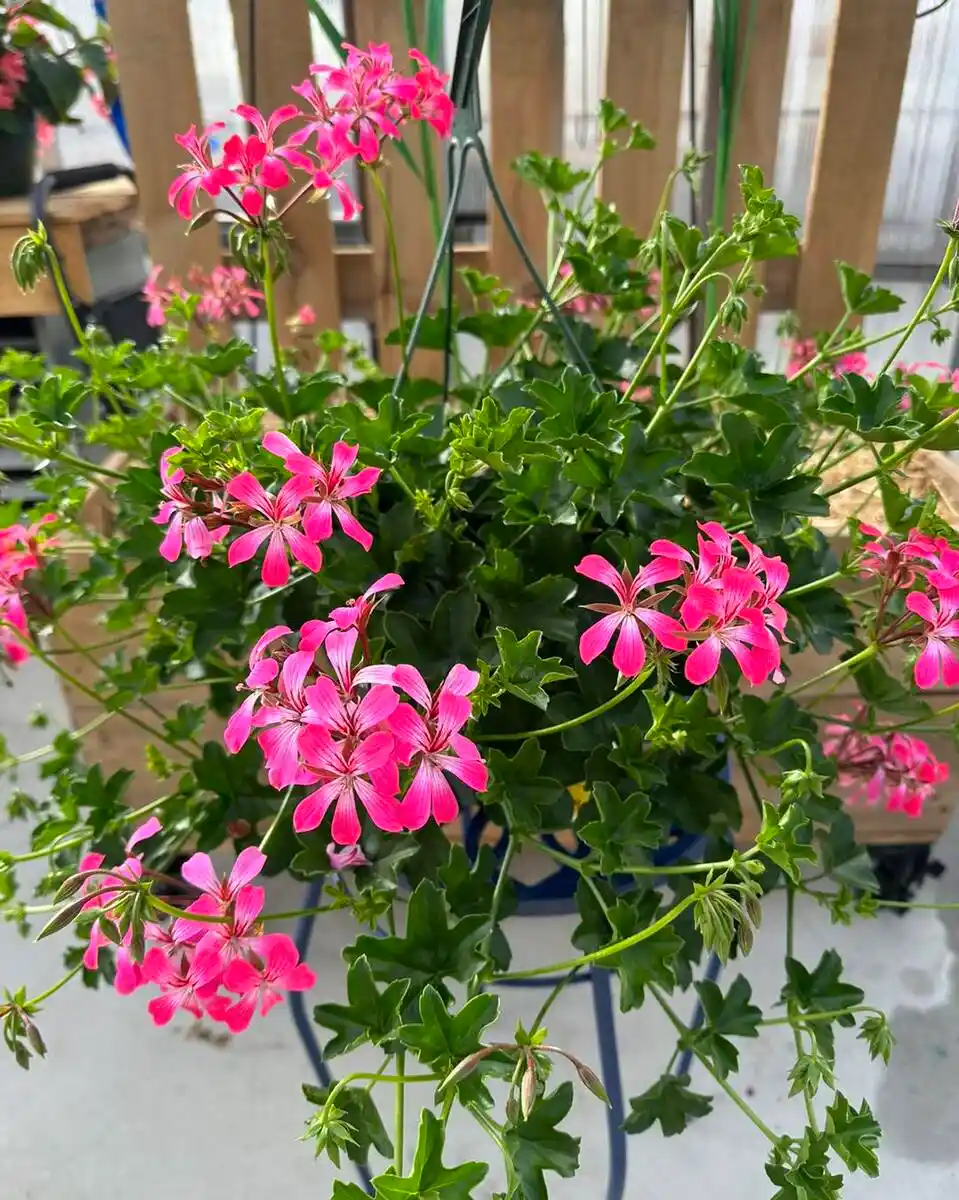
Ivy geraniums are basket icons. The trailing stems carry clusters of red or cherry-pink that hummers absolutely notice. I like them as the structural backbone in mixed baskets with calibrachoa tucked at the edges.
Full sun to part sun, well-drained soil, and a light hand with fertilizer keep them compact and floriferous. Typically annual; perennial in Zones 9–11. Deadhead the umbel stems and don’t let soil stay soggy.
Bacopa (Sutera cordata) — white “star confetti” that sets off red tubes
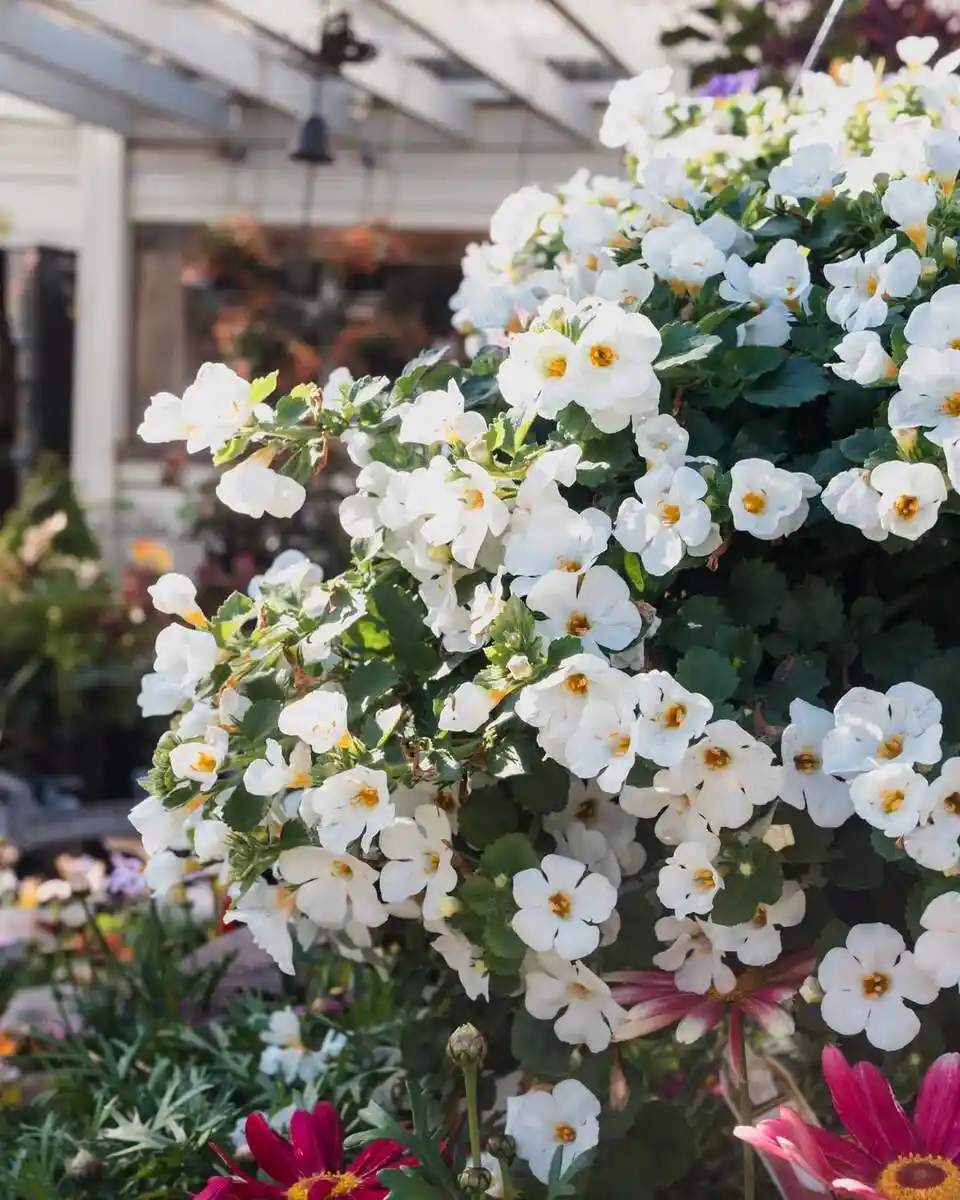
Bacopa’s tiny white or lavender stars aren’t the primary nectar engines in my mixes, but as a contrast partner for bold red tubes (salvia, cuphea), it shines. The simple, open faces still get occasional visits while making the basket look fuller and softer.
Give full sun to part shade, keep evenly moist (it can sulk if dried hard), and shear lightly to refresh. Annual in most zones; tender perennial in 9–11.
Nemesia — sweet perfume + spring/fall color
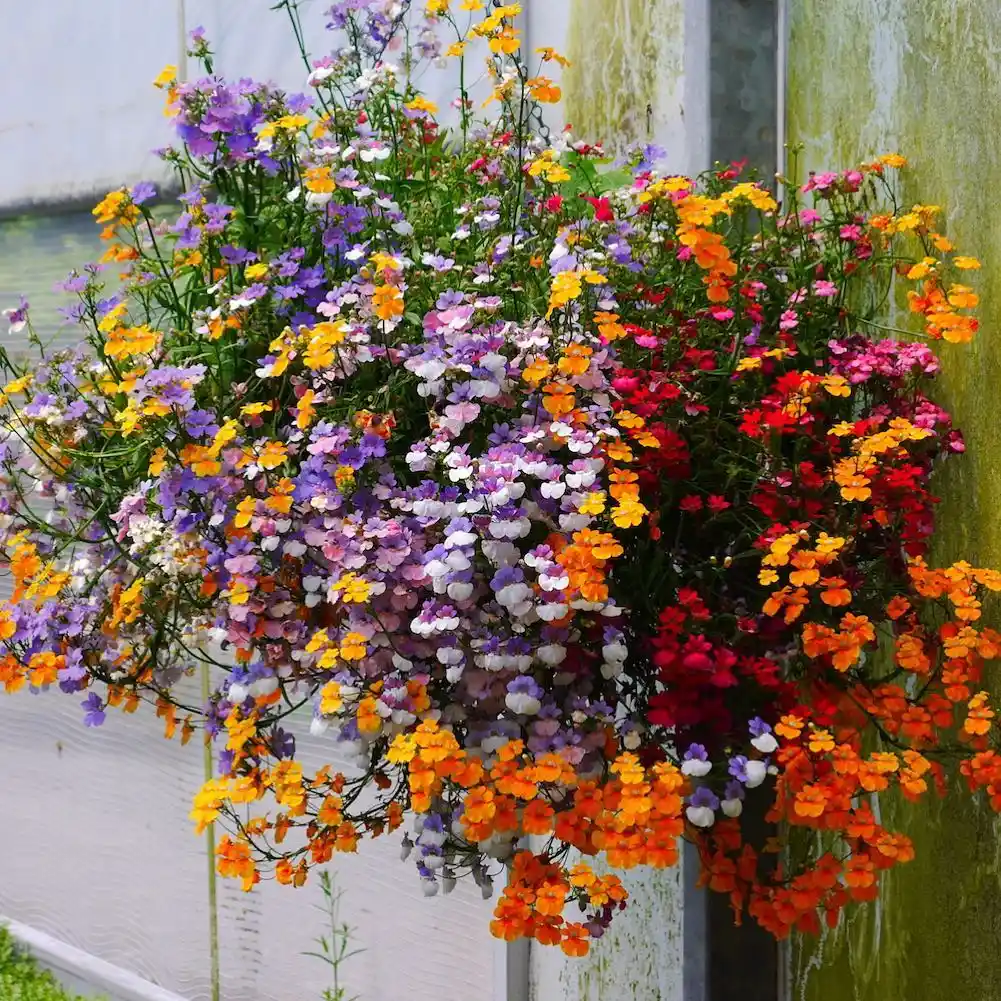
Nemesia brings sherbet colors and a gentle scent. In my climate it peaks in spring and again in fall when nights cool. Mix it near basket rims for color drift that hummers notice as they work the more tubular neighbors.
Grow in full sun to part sun with excellent drainage and steady moisture. It’s tender (Zones 9–11), often an annual. Deadhead to keep flushes coming.
Diascia — coral drifts for shoulder seasons
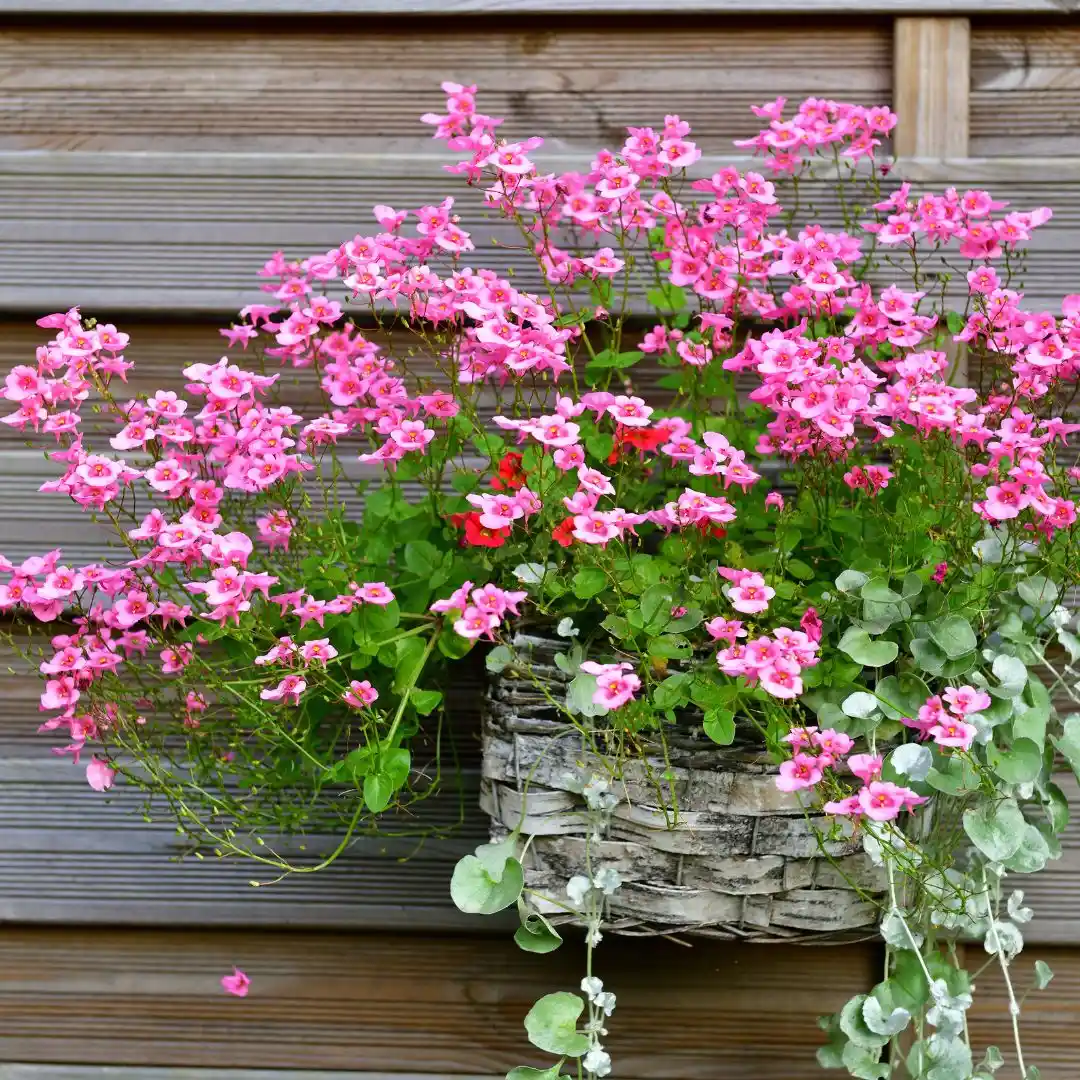
Diascia feels like a quiet friend who always shows up. Coral and peach tones soften bold plantings and create warm landing spots around tubes. Hummingbirds work these small flowers in quick loops.
Plant in full sun to light shade, keep soil moist but not wet, and shear lightly mid-summer if bloom dips. Tender perennial in Zones 9–11, usually annual.
Scaevola (fan flower) — heat-tough spiller with a unique shape
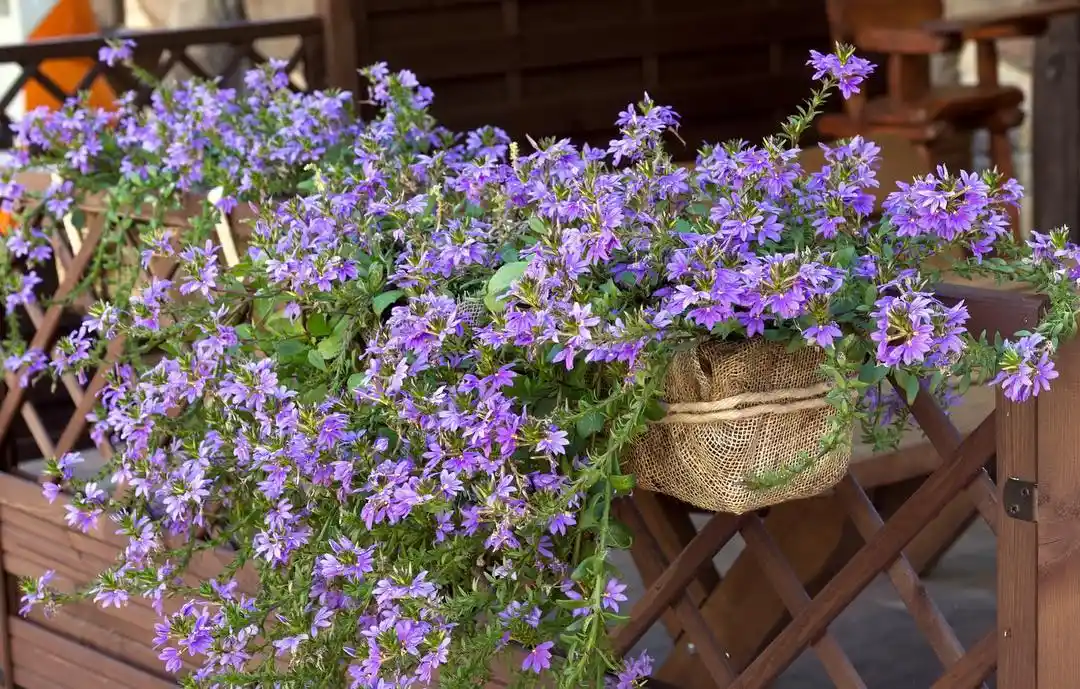
Not tubular, but the fan-shaped petals and constant bloom make scaevola a superb basket spiller. I love it with lantana—blue fans + hot citrus clusters is designer-level contrast, and the basket never looks tired in August.
Give full sun, very sharp drainage, and let it dry a touch between waterings. Zones 10–11 perennial; elsewhere annual. Deadheading isn’t required; just trim stragglers.
Sweet Alyssum — honey scent that signals “free snacks”
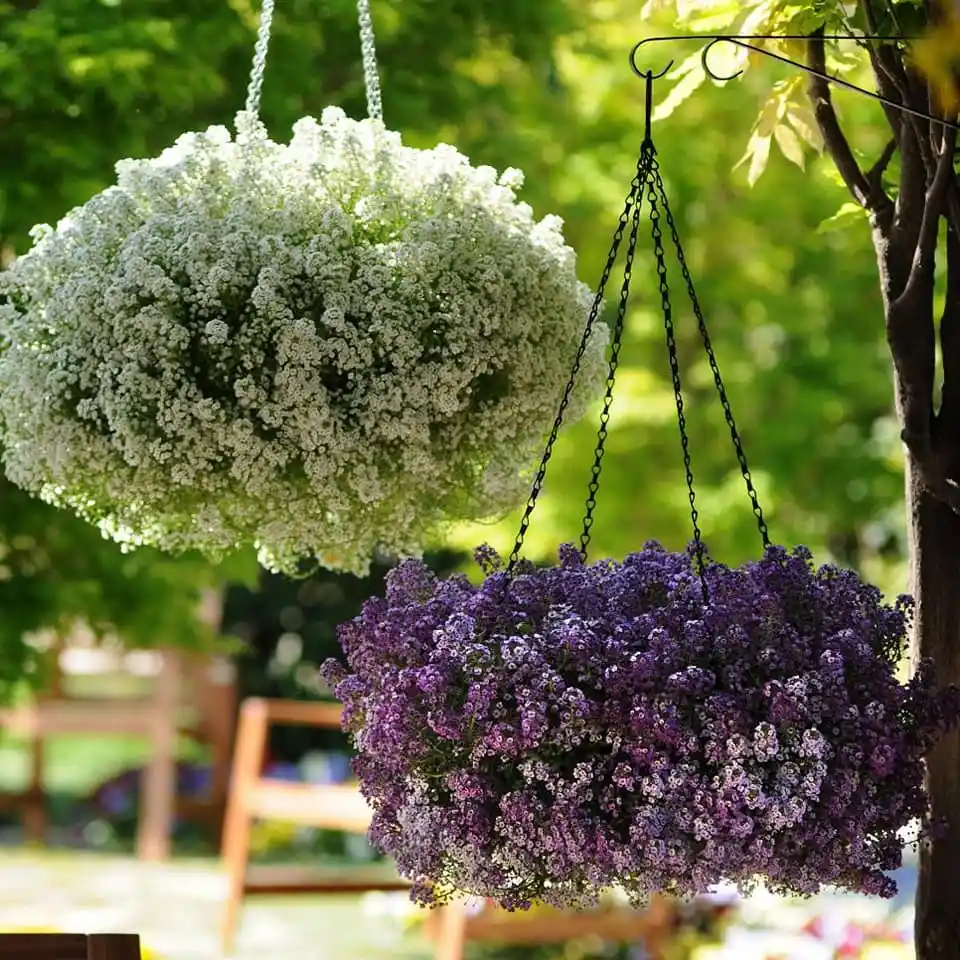
The honey fragrance drifts, and hummingbirds notice—especially near rest spots. Use white for the brightest pop and to set off reds. It’s a simple way to make your porch smell like a garden party.
Plant in full sun to light shade; it likes cooler temps, but modern varieties keep going in summer with steady water. Annual in most places; tender in Zones 9–11. Trim when it gets leggy and it rebounds fast.
Black-eyed Susan vine (Thunbergia alata) — cheerful climber for tall baskets
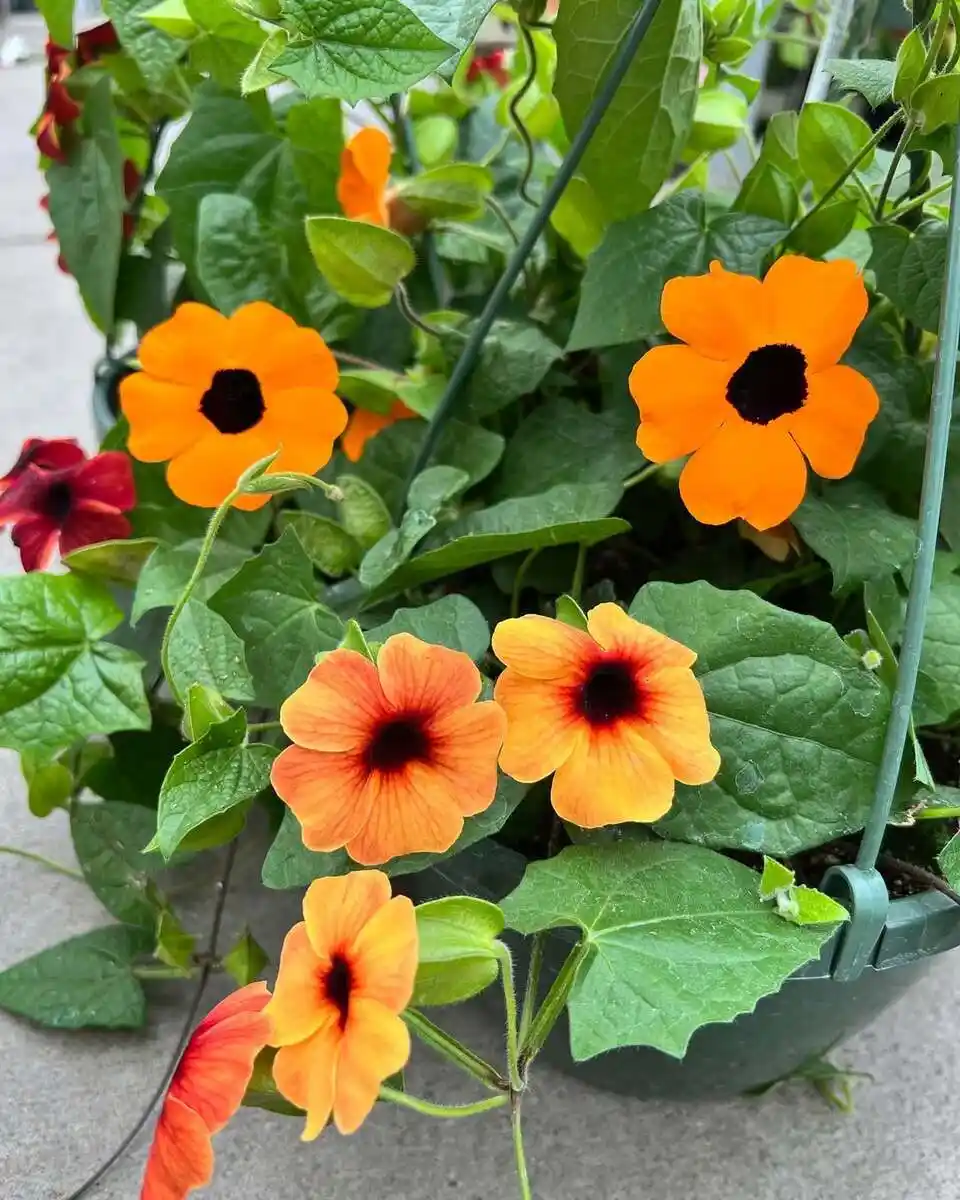
Want a basket that feels hand-painted? This vine trails and twines with buttery petals and a dark eye at the center. The simple flower shape isn’t tubular, but the color is loud and the bloom count is huge, which keeps visitors curious.
Give full sun, a roomy hanger with a small trellis or chain to climb, and regular water. It’s tender (Zones 10–11), so treat as an annual in most regions. I combine it with red salvia in the same pot and the result is a hummingbird magnet with movement and height.
Morning Glory (Ipomoea tricolor and others) — sky-blue trumpets at breakfast
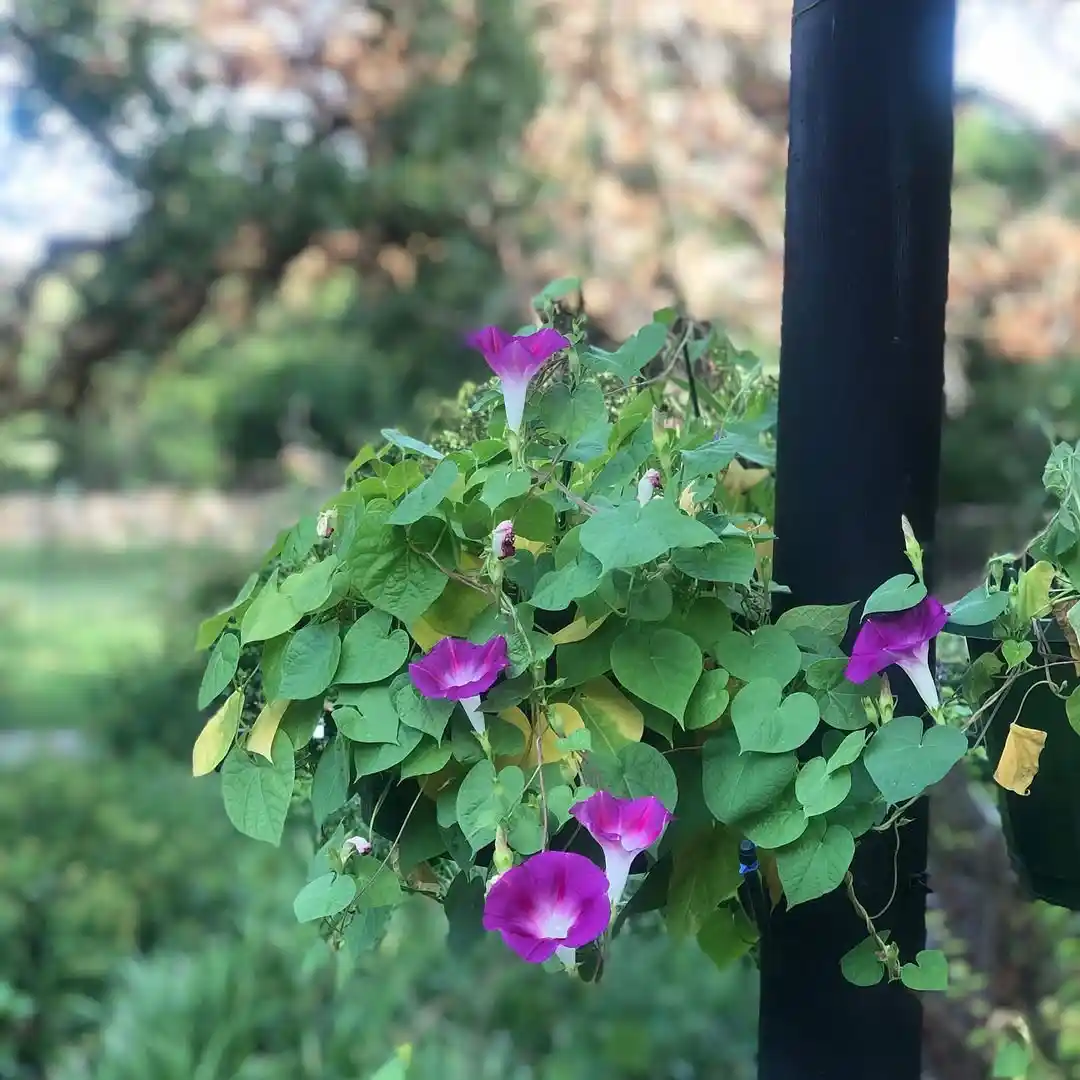
I’m fond of a single morning glory basket on a high hook; the vines drape and the trumpets open with the sun. Hummingbirds catch that early nectar like a drive-through on their morning route.
Full sun, warm soil, and moderate water once established. It’s annual in most climates; in frost-free zones it can reseed. Give it strings or a dangling hoop to wrap.
Mandevilla (and dipladenia) — glossy leaves + tropical tubes
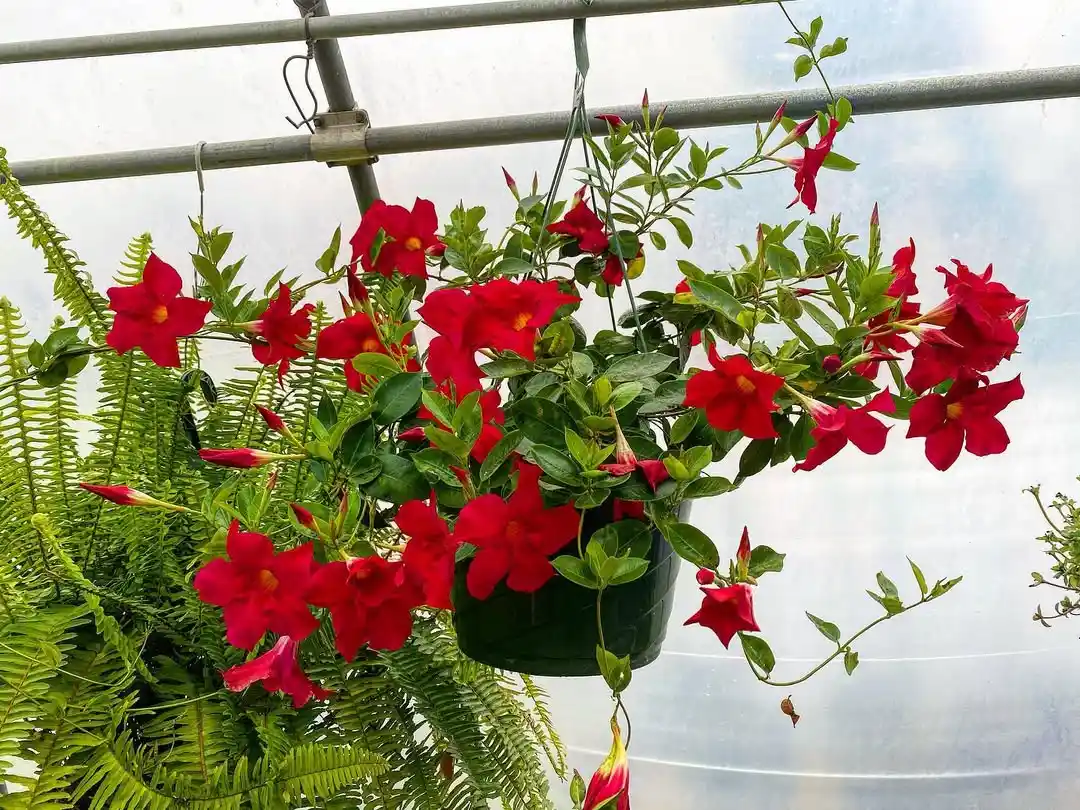
If your vibe is resort patio, this is your star. Big, waxy trumpets in lipstick red or hot pink make a bold nectar target. I run mandevilla solo in a coco-lined 14″ basket with a hoop and let it drape and climb all at once.
Full sun, steady water in summer heat, and a richer potting mix than you’d use for succulents. Perennial in Zones 9–11, annual elsewhere. Give monthly light pruning on the tips to branch and flower more.
Browallia (amethyst flower) — violet haze for part shade
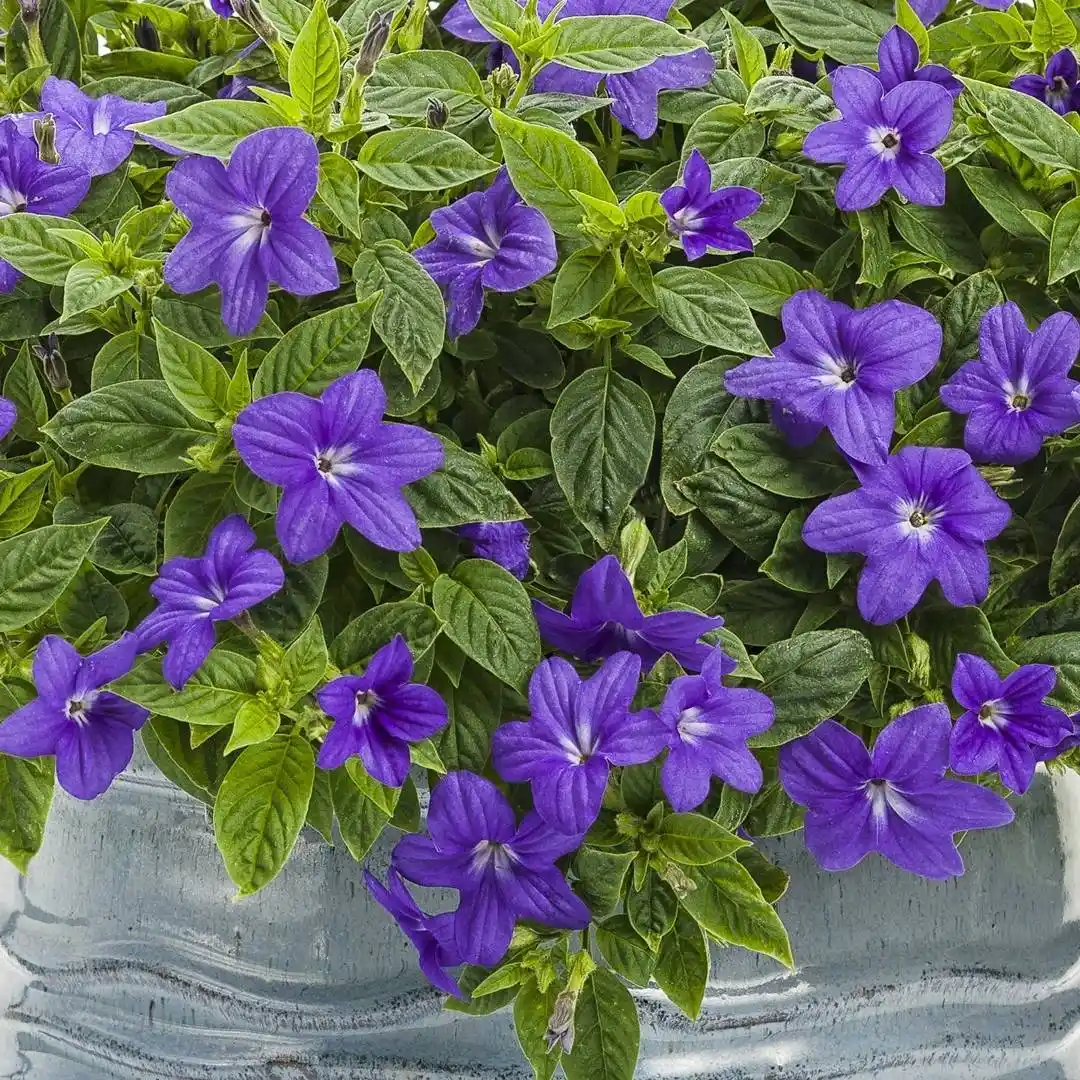
For porches that never get harsh afternoon sun, browallia fills the gap with cushiony mounds of violet-blue blooms. Hummingbirds do stop in, especially when it’s paired with hotter colors nearby.
Part shade, evenly moist soil, and gentle feeding keep it blooming. It’s tender (Zones 9–11), used as an annual in baskets. I like it as a color bridge between white alyssum and hot pink calibrachoa.
Torenia (wishbone flower) — under-used gem for shade baskets
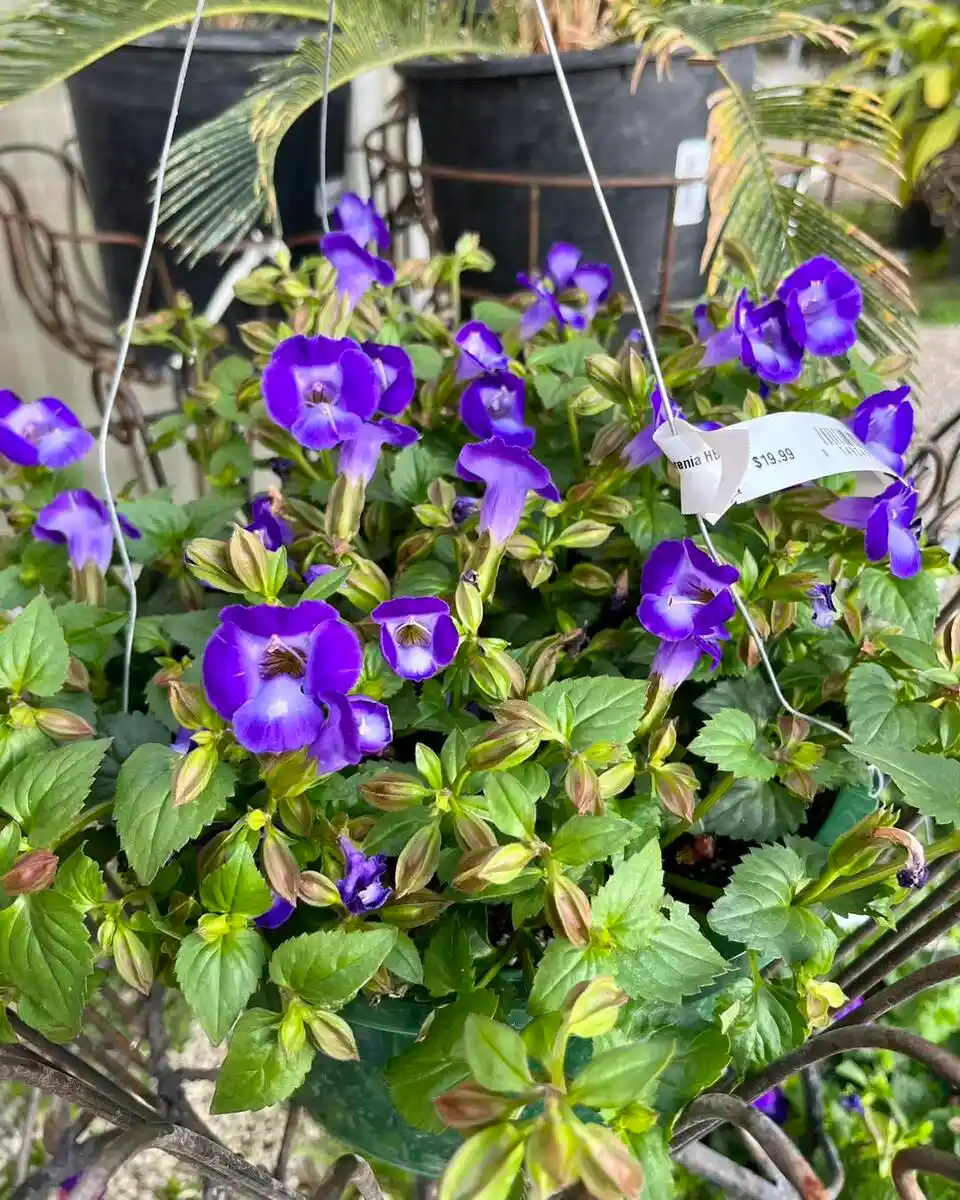
Torenia makes adorable, tubular flowers with a little “wishbone” inside the throat—fun to show kids. The plant stays neat and hummingbirds notice the shape even in dimmer light.
Bright shade to part shade, consistent moisture, and sheltered positions out of wind are ideal. It’s generally annual, tender perennial to Zone 10+. If your porch is dark, this and fuchsia are my top picks for actual bird visits.
Russelia (firecracker plant) — fountain of red tubes for big baskets
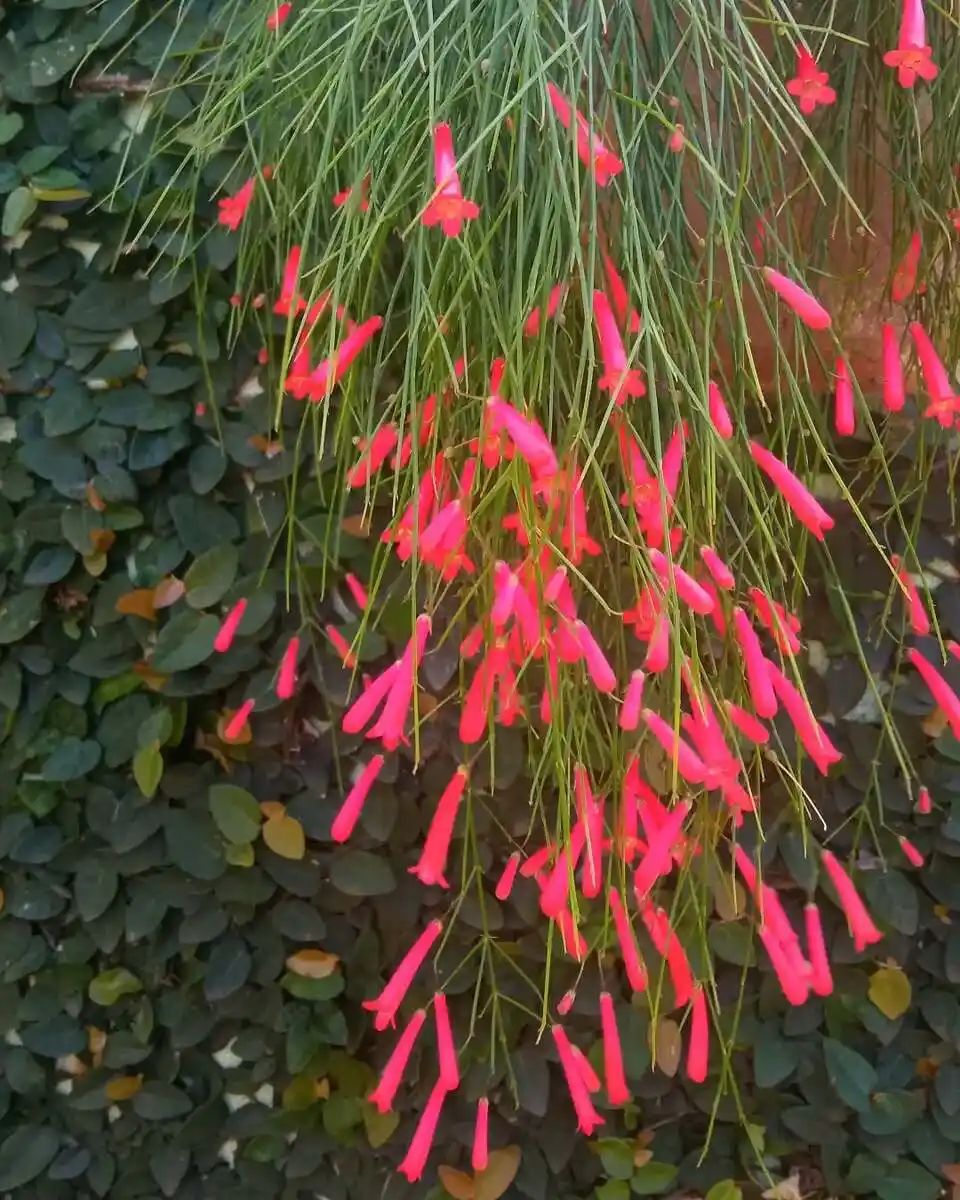
When you want drama, russelia delivers: arching stems and dozens (hundreds!) of thin red tubes cascading like fireworks. I put it in a deep, sturdy basket because it gets substantial and the hummers treat it like a buffet line.
Full sun and excellent drainage; drought tolerant once established. Tender (Zones 9–11), normally annual elsewhere. Trim lightly to keep arching form neat. It pairs beautifully with a skirt of white bacopa.
How I layer the best hanging flowers to attract hummingbirds (design + care)
My formula for mixed baskets:
One thriller (tall/eye-catching nectar: mandevilla, russelia, or salvia), two fillers (calibrachoa, verbena, bidens), and at least one spiller (lobelia, scaevola, ivy geranium). That balance gives height, body, and flow—and gets you consistent visits. Spacing baskets at different heights multiplies feeding zones, which absolutely matches what I see on my porch.
Soil & feeding:
Use a high-quality soilless mix with added perlite for drainage. Blend slow-release fertilizer at planting, then supplement every 7–14 days at half-strength. Baskets dry fast, so water deeply until it flows from the bottom, then let the top inch dry before repeating.
Sun & placement:
Match plant to exposure—fuchsia/impatiens for shade; petunia/lantana/verbena for full sun. Put at least one basket near a seating spot (selfish, I know) so you can enjoy the fly-bys at eye level.
Maintenance:
Pinch or shear midseason to rebuild bloom; a quick haircut plus feed can reboot a tired basket in 10 days. Remove spent umbels on geraniums, deadhead petunias/calibrachoa weekly, and flush soil monthly to prevent salt buildup.
Proven combos of hanging flowers to attract hummingbirds (by sun level)
Full Sun (6–8h): Petunia + Lantana + Verbena + Scaevola
Hot Patio (8h+): Mandevilla + Cuphea + Bidens
Morning Sun/Afternoon Shade: Calibrachoa + Lobelia + Ivy Geranium
Bright Shade: Fuchsia + Torenia + New Guinea Impatiens
Shoulder Seasons (Spring/Fall Cool): Nemesia + Diascia + Sweet Alyssum
Each mix layers tubular shapes with high bloom counts to keep birds circling. These reflect the same plant families commonly highlighted for hummingbird basket winners.
Placement hacks to supercharge your hanging flowers to attract hummingbirds
- Height variety: one basket near eye level, one just above head height, one high (makes a little nectar ladder).
- Wind breaks: tuck baskets near walls or railings; hummers don’t love fighting wind to feed.
- Red signal: even one red plant (salvia, fuchsia, mandevilla) acts as a visual cue and pulls birds to the rest.
- Clean nearby water: a dripper or shallow bubbler gives them sips between nectar rounds.
- No chemicals: avoid systemic insecticides—those can contaminate nectar.
Seasonal plan: keep your best hanging flowers to attract hummingbirds blooming from spring to frost
Early spring: Plant cool-friendly sets (nemesia, diascia, lobelia, sweet alyssum).
Early summer: Swap in heat lovers (petunia, calibrachoa, lantana, scaevola, bidens).
Midsummer tune-up: Shear, refresh soil surface, light feed.
Late summer/fall: Re-add cool lovers if your nights dip; keep red tubes present for late migrants.
Troubleshooting your hanging flowers to attract hummingbirds
- Great foliage, few flowers: ease up on nitrogen, add more sun, pinch to branch.
- Blooms stalling midseason: haircut + feed + 10 days.
- No bird visits yet: add one high-contrast red tubular plant and shift a basket closer to open flight paths (porch edge).
- Drying out daily: move to a slightly larger basket and water in the morning; add water-retentive fibers, but still prioritize drainage.
Region notes (USDA zones) for hanging flowers to attract hummingbirds
Most of the stars here are perennial only in warmer zones (9–11), so in colder regions treat them like annuals or overwinter indoors by bright windows. Lantana can hold in Zone 8, verbena varies by species (some hardy to 6–7), and hardy fuchsias can survive to Zones 6–7 with protection. The tactic stays the same either way: think season-long nectar first, winter storage second.
Why these hanging flowers to attract hummingbirds keep showing up in trusted lists
Independent roundups consistently spotlight the same players—fuchsia, petunia, calibrachoa, lantana, verbena, lobelia, impatiens, begonias, mandevilla, and more—because they combine easy container culture with reliable nectar access and nonstop color. Smart placement (vary heights, avoid pesticides) also increases visits.
FAQ: hanging flowers to attract hummingbirds (quick answers)
1) What are the absolute easiest hanging flowers to attract hummingbirds for beginners?
Petunia + calibrachoa + verbena in one sunny basket. They forgive imperfect watering and bloom like crazy. Fuchsia + torenia + impatiens for bright shade.
2) How many baskets do I need to notice a difference?
Three baskets at different heights usually flips the switch from occasional to constant visits. This mimics multiple “stations,” which helps tiny birds feed without fuss.
3) Do I need red blooms, or will any color work?
Red and hot oranges are strong visual cues, but hummingbirds also visit purples, pinks, and whites. I always include at least one red tube (salvia, mandevilla, fuchsia).
4) What basket size is best?
For mixed plantings, 12–14″ across and deep enough to hold moisture. Big baskets buffer heat and allow roots to breathe, which means more blooms and nectar.
5) How often should I feed plants in hanging baskets?
Use slow-release at planting and supplement every 1–2 weeks at half-strength. Baskets leach nutrients quickly due to frequent watering.
6) Which hanging flowers to attract hummingbirds handle heat the best?
Lantana, scaevola, bidens, mandevilla, and cuphea are my heat crew. Pair them and water deeply in the morning.
7) Will hummingbirds skip non-tubular flowers?
Not always. Tube shapes are ideal, but sheer bloom quantity and strong colors (petunia, bidens, alyssum) still get visits—especially when mixed with tubular neighbors.
8) My porch is mostly shade—what should I plant?
Fuchsia, torenia, impatiens, lobelia, and boliviensis begonias. Keep moisture steady, add gentle airflow, and avoid hot afternoon sun on these.
9) Can I grow these as perennials?
Yes in warm zones (often 9–11). Otherwise, either treat as annuals or overwinter indoors with bright light and lighter watering.
10) Do I still need a feeder?
Optional. I run one feeder set away from baskets so birds can choose. Natural nectar plus clean feeders cover both energy and habit. Clean feeder sugar water frequently if you use one.
11) What’s the most underrated plant on this list?
Cuphea. It’s adorable, heat-hardy, and those odd little tubes seem to ring a dinner bell all day.
12) How close should baskets be to where I sit?
I hang one at eye level near a chair or window. The best part of hanging flowers to attract hummingbirds is actually watching them—so invite them right where you spend time.
13) How do I keep baskets from drying out?
Use bigger baskets, water early, mulch the surface with decorative moss or coco fiber, and add a dash of water-holding amendment (but never at the expense of drainage).
14) Can I mix edibles with my hummingbird flowers?
Yes—nasturtium is edible and gorgeous. You can also tuck in trailing thyme or strawberries for fun, without losing the nectar party.

